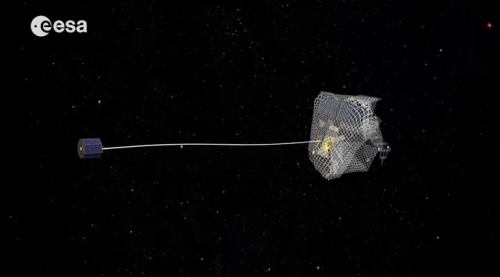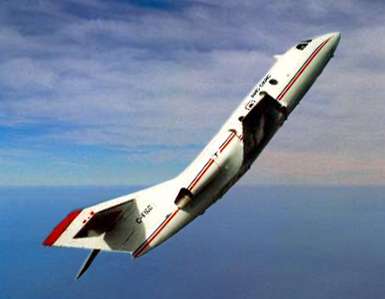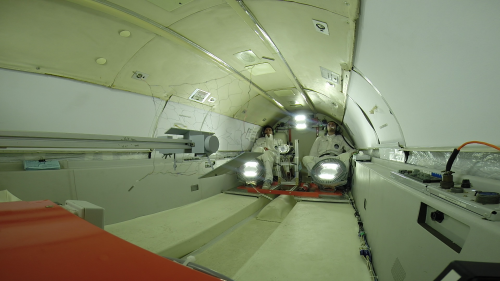One capture concept being explored through ESA's e.Deorbit system study for Active Debris Removal - capturing the satellite in a net attached to either a flexible tether (as seen here) or a rigid connection. Credit: ESA
One of humanity's oldest technologies, the humble fishing net, may yet find a new role in space: bringing down dead satellites.
The behaviour of nets in orbit was recently checked on an aircraft flying parabolic arcs to create brief periods of weightlessness.
"We shot nets out of a compressed air ejector at a scale-model satellite," explains ESA engineer Kjetil Wormnes.
"We fired 20 nets at various speeds during 21 parabolas over two days. Packed inside paper cartons, the nets were weighted at each corner, helping them to entangle the model satellite.
"The good news is they worked extremely well – so much so that the nets usually had to be cut away with a knife before we could shoot again."
The Falcon 20 aircraft is flown so that for 20 seconds at a time it falls through the sky, effectively cancelling out gravity inside the aircraft.
"Everything was recorded on four high-speed HD cameras," Kjetil added. "The aim is to check the simulation tool we have developed, so that we can use it to design the full-size nets for a debris removal mission."
The rainbow-hued nets were designed to be easily followed on camera. Of the two variants used, the thinner spun versions proved more effective than the thicker, woven design.
ESA's e.Deorbit mission in 2021 will test the feasibility of removing a large item of debris – either a large derelict satellite or rocket upper stage – to help control the debris levels in busy orbits.
Weightless net testing for derelict satellite capture. Credit: ESA
The best method of snagging an uncontrolled, tumbling satellite is still being decided. ESA's Clean Space initiative to reduce the impact of the space industry on the terrestrial and orbital environments is overseeing studies that also include a robotic arm, a harpoon and an ion beam.
The oldest known fishing net was uncovered by a Finnish farmer in 1913. Its willow mesh was carbon dated to 8300 BC, making it several thousand years older than the wheel.
"The main advantage of the net option, whether for e.Deorbit or other debris removal missions in future, is that it can handle a wide range of target shapes and rotation rates," Kjetil explains.
-
Canada's Falcon 20 parabolic aircraft. Credit: ESA
-
Weightless net testing. Credit: ESA
Provided by European Space Agency

























